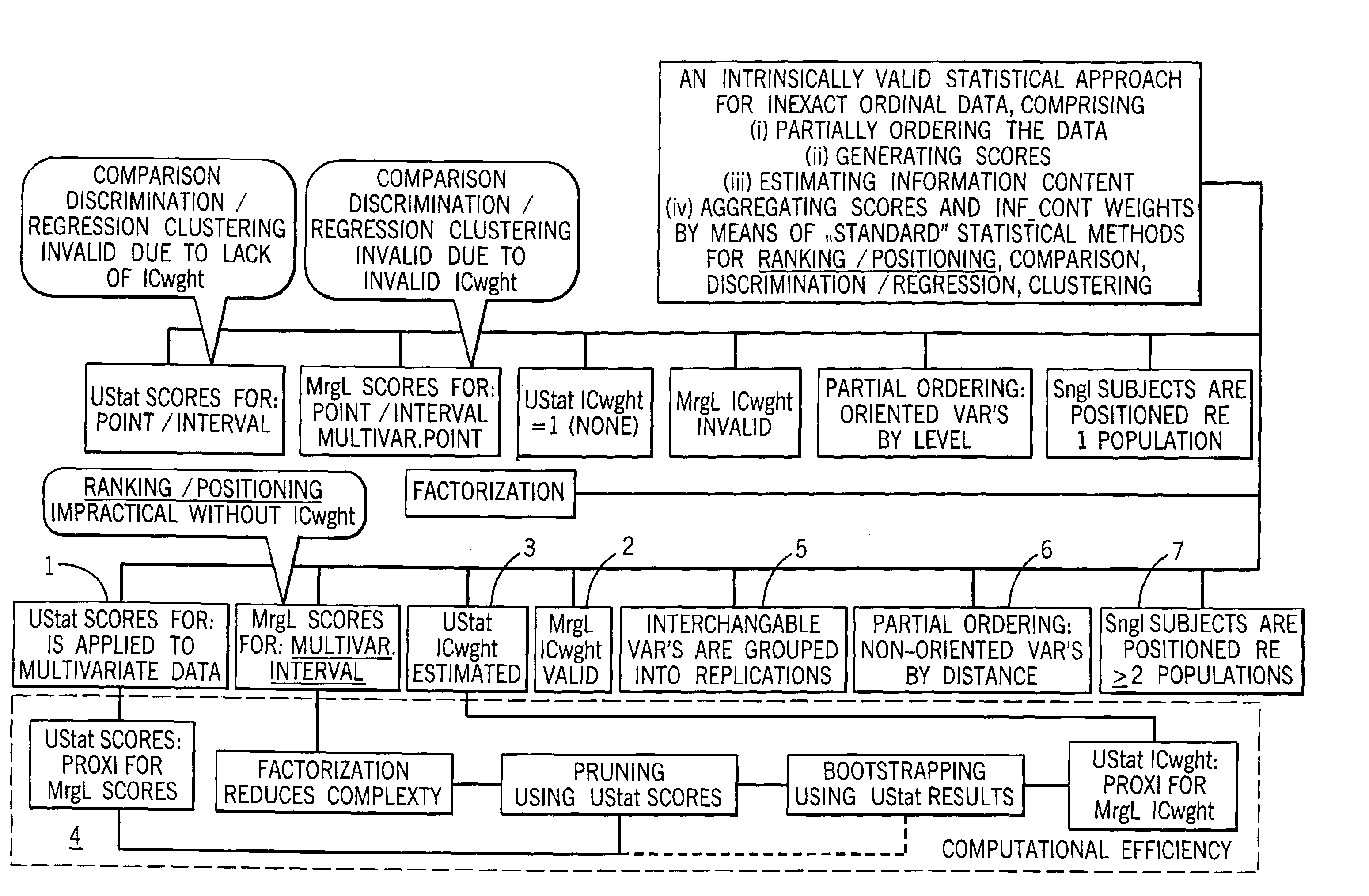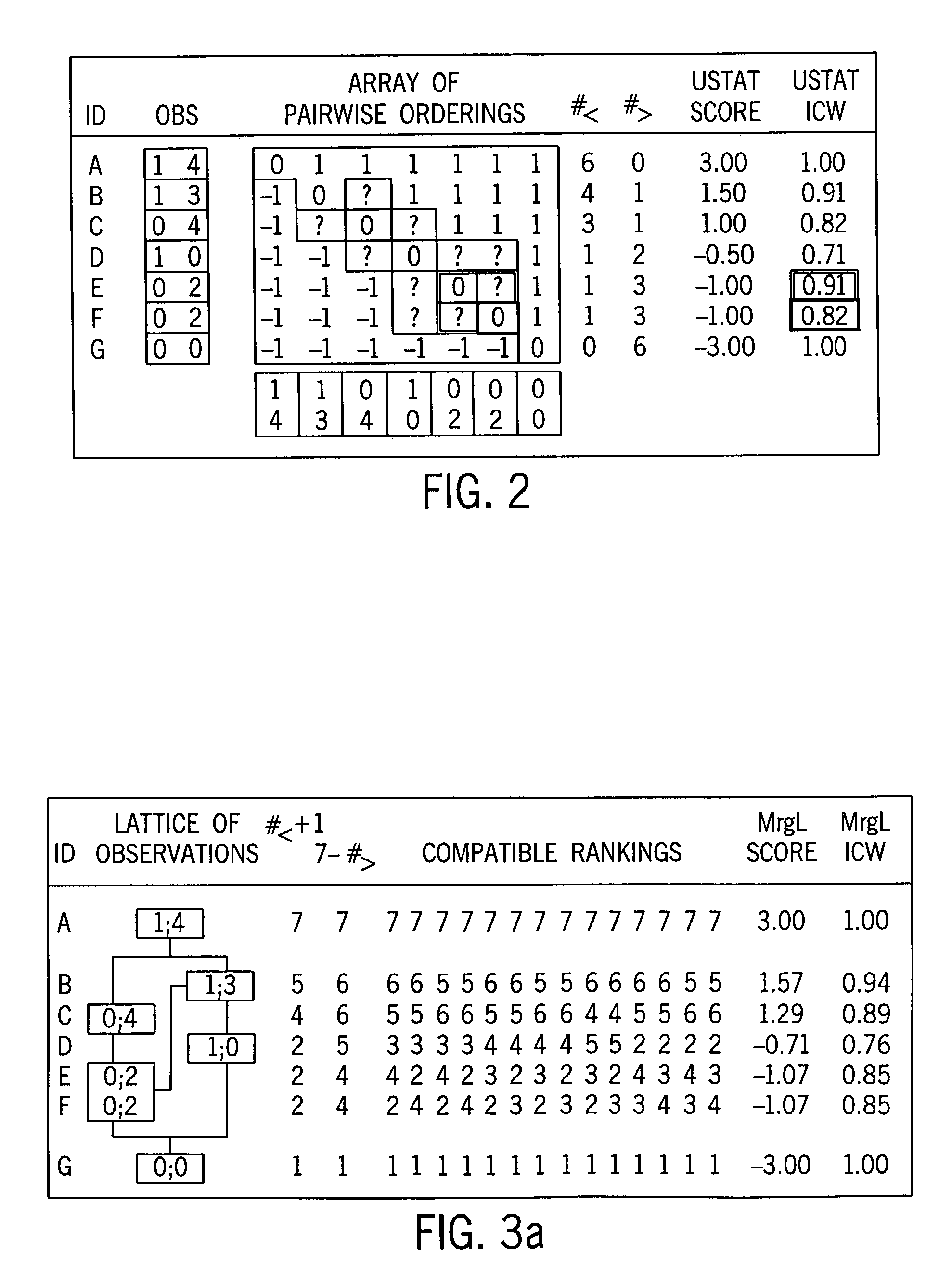Statistical methods for multivariate ordinal data which are used for data base driven decision support
a statistical method and data technology, applied in the field of statistical methods for multivariate ordinal data which are used for data base driven decision support, can solve problems such as inability to determine, and achieve the effect of increasing the time to be spent and increasing the accuracy and stability of the approximation
- Summary
- Abstract
- Description
- Claims
- Application Information
AI Technical Summary
Benefits of technology
Problems solved by technology
Method used
Image
Examples
example 1
Ranking Countries by Gold, Silver, and Bronze Medals
[0199]In order to illustrate the general applicability of the invention we provide an evaluation of computing UStat scores for data with arbitrary partial orderings for a reanalyzation of the medal counts from the 2002 Winter Olympics in Salt Lake City.
[0200]A total of n=25 countries Ci won at least one medal at the 2002 Winter Olympics. Let gi, si, and bi denote the number of gold, silver, and bronze medals won by country Ci. Four different linear model weighting schemes are commonly used to rank countries.
[0201]
Identical:IScr = g + s + bLinear:LScr = 3g + 2s + 1bExponential:EScr = 22g + 21s + 20bHierarchical:HScr = ┌maxibi┐ ┌maxisi┐g + ┌maxibi┐s + b
where a ceiling ┌x┐ is any integer larger than x. Since no country had more than 100 medals in any category, 100 can be used as the ceiling for both bronze and silver medals.
[0202]Table 1 gives the medal counts and the different rankings for three commonly used weighting schemes (unifo...
example 2
Quantitative Trait Loci for Atherosclerosis Susceptibility in Apolipoprotein E-Deficient Mice
[0215]ApoE-deficient mice on 6 inbred genetic backgrounds were compared for atherosclerosis lesion size in the aortic root in two independent studies. Data was normalized to to the C57BL / 6 strain, which was used in both studies. A mouse SNP database was then used to correlate lesion size with SNP pattern on chromosome 1, where atherosclerosis QTL had been previously identified through analyses of an F2 cohort derived from apoE-deficient mice on the C57BL / 6 and FVB / N strains. The in silice QTL are candidates for further study to confirm the presence of, and identify, atherosclerosis susceptibility genes.
[0216]Coronary heart disease (CHD) is the most common cause of death in the United States. Most cases of CHD can be attributed to or associated with atherosclerosis, a complex disease often initiated by hypercholesterolemia involving both environmental and genetic factors. Large epidemiologica...
example 3
Identifying Genetic Risk Factors for Relapse
[0241]Even after successful treatment, relapse is a problem with many diseases. In our studies with melanoma patients (see EXAMPLE 4), for instance, some patients had a lasting clinical response, while others relaped even though their response seemed initially favorable. The genetic risk factors predisposing patients for recurrence are unknown.
[0242]Among a population of 800 patients who initially responded favorably to initial treatment, almost 50% developed a recidiv. About 80 genetic markers were informative and evaluated to identify locations for genes that might be involved in putting patients at risk for a recidiv. For each of the loci with genetic variation, one allele was randomly called as “A” and the other as “B”. Patients homozygous for one of allele were then coded as “1”, heterozygous patients as “2”, and patients homozygous for the other allele as “3”.
[0243]The data is displayed in FIG. 12.
[0244]First a traditional analysis b...
PUM
 Login to View More
Login to View More Abstract
Description
Claims
Application Information
 Login to View More
Login to View More - R&D
- Intellectual Property
- Life Sciences
- Materials
- Tech Scout
- Unparalleled Data Quality
- Higher Quality Content
- 60% Fewer Hallucinations
Browse by: Latest US Patents, China's latest patents, Technical Efficacy Thesaurus, Application Domain, Technology Topic, Popular Technical Reports.
© 2025 PatSnap. All rights reserved.Legal|Privacy policy|Modern Slavery Act Transparency Statement|Sitemap|About US| Contact US: help@patsnap.com



